SEO Siloing: How to Build a Website SEO Silo
Silos: the recommended method of architecting your site content so that it clearly communicates subject expertise and authority to search engines. Search engines award top keyword rankings to the site that proves it’s the most relevant fit for the theme and intent of the user’s query. As a result, the primary goal of search engine optimization (SEO) is to improve the website so that the site is about more than targeted keyword phrases — it is about the themes matching those keywords.
More often than not, a website is a disjointed array of unrelated information with no clear central theme. Such a site suffers in search engine rankings for sought-after keywords.
Siloing a website serves to clarify its subject expertise and lays the groundwork for high keyword rankings. It is a core building block for SEO and is normally an advanced topic.
The term siloing originated as a way to identify the concept of grouping related information into distinct sections within a website. Much like a chapter in a book, a silo represents a group of themed or subject-specific content on your site. However, in like “clusters” that are limited to fenced in keywords, silo structures link to complementary parts of the website sufficient to demonstrate association without diluting the concentration of information on the silo theme.
The reason this grouping has such a high SEO priority is that search engines award keyword relevancy within their index based on the page and then the interlinked rest of the site with the most supporting relevant content. This contributes in particular to Google’s evaluation of a site’s expertise, part of the E-E-A-T quality factors (experience, expertise, authority and trustworthiness).

Well-ranked websites are founded upon the concept that a website should physically be organized like a doctoral dissertation. A dissertation has a clearly identified title, abstract, table of contents, and then content laid out to reinforce the overall theme of the dissertation as a whole, all with references and footnotes supporting the subject.
Often, there are great websites hidden from widespread search engine result pages (SERPs) exposure. They may lack an organic search engine optimization strategy, or their strategy does not include enough attention to clear subject relevance or siloing.
In this document, you will find a strategy for improving the clarity of a website’s overall theme through siloing. The intent is to improve the site’s keyword rankings.
Introductory Siloing Overview
Siloing a website requires a multistep process of planning and implementation.
Step 1: Determining Website Theme
Begin the process of siloing by determining your website theme. Answer questions including:
- What subject themes are currently ranking for your website?
- What subject themes are legitimately relevant for your website?
- How would a user search for your content (main search queries)?
- How can you implement clear subject themes?
Step 2: Building a Website Theme with Physical Silos
Consider whether you can implement physical siloing through the site’s directory structure, and apply this if possible. We will later discuss the practice of virtual siloing, in which navigation and linking determine the themes.
Step 3: Building a Website Theme with Virtual Silos
Carefully examine the link structure implemented throughout the site, applying linking techniques between pages that reinforce site themes.
Step 4: Creating Keyword-Rich Content
Publish relevant, expert-quality content that includes targeted keyword phrases within appropriate silos.
Step 1: Determining Website Theme
Google’s mission as stated on the company information page is “to organize the world’s information and make it universally accessible and useful.”
There are many factors of varying importance to consider when understanding how the search engines rank sites and determine each site’s relevance to searcher queries. However, a website’s subject matter expertise and clear themes are quite important to the ranking of the site.
To rank for keywords in Google and Bing, a site must provide information that is organized in a clear structure and format that search engines understand.
When a site’s information has been stripped away from its design and layout, will it be the most relevant of all similarly themed sites? If so, then it has a high likelihood of achieving high rankings. In turn, search rankings enable a site to attract customers researching and shopping for products and services.
Siloing is not all there is to ranking, but without it the on-page relevancy battle is lost.
The on-page process of achieving high rankings begins by having a clear understanding of a site’s subject themes. When speaking at conferences and in training, Bruce Clay often explains the importance of creating subject themes, or silos, by using the analogy that most websites are like a jar of marbles. He states that a search engine can only decipher meaning when the subjects are clear and distinct. Look at the picture of a jar of marbles in Figure 1 and contemplate how search engines will classify the “theme” of this jar.

Figure 1: Jar of mixed marbles
In the jar, we see green marbles, red marbles and yellow marbles mixed together with no order or emphasis. It would be reasonable to assume that search engines would classify the subject as a jar of marbles.
If we separate out each group of colored marbles into separate jars, they would be classified as a jar of green marbles, a jar of red marbles, and a jar of yellow marbles (Figure 2).
 |
 |
 |
Figure 2: Jars of separated marbles
However, if we wanted to include all three marbles in a single jar, we could create distinct groupings in the jar (Figure 3) that would allow the subject themes to remain separate as green marbles, red marbles, yellow marbles as well as the generic term marbles.

Figure 3: Jar of siloed marbles
The first mixed up jar of marbles (Figure 1) is a non-siloed website. The three separate jars represent three separate sites (Figure 2). The last jar equates to one site with topics separated into theme-specific categories, or silos (Figure 3). The goal for a site that wants to rank for more than a single generic term is to selectively decide what the site is and is not about.
Rankings can be damaged in two common ways: 1) including irrelevant content or 2) having too little content about a subject. Avoid these mistakes by knowing the focus for the site and avoiding irrelevant subject matter.
What Subject Themes Does Your Website Currently Rank For?
The best place to start identifying the relevant themes for a site is to examine the historical traffic data of the website. First, examine the data from the following sources:
- Google Search Console
- PPC Programs
- Tracked Keyword Phrases
- Keyword Research
Each of these sources of information will provide information about who visits the website and why. It won’t directly explain why the site isn’t ranked for desired keywords, but it will help evaluate which themes of the site the search engines recognize.
Google Search Console
Organic queries are shown in Google Search Console’s Performance report by Queries. You can see what queries caused your pages to show up in search results (impressions) as well as which ones actually brought Google searchers to your site (clicks) in the past three months.
Note: If you have not done so already, be sure to set up Google’s tools for webmasters, Google Search Console and Google Analytics. You may also set up Bing Webmaster Tools for additional data. These free tools provide invaluable analytics you need.
PPC Programs
If you use Google Ads or Bing Ads to do pay-per-click advertising, you’ll have even greater insight into exactly which keyword phrases work to bring searchers to your website. You can also use PPC as a testing environment, bidding on phrases you would like to be relevant for within the organic search arena but for one reason or another have not yet ranked for organically.
Tracked Keyword Phrases
The last and most accessible method of discovering your website’s most important subject themes is to ask people within your company which keywords are most important. By interviewing the president, marketing team and sales managers, you can often get an idea of what the company is trying to rank for in organic search results. The phrases they use generally match the content, so it would be useful to validate the expectations against the reality of the site.
Keyword Research
After creating a list of 10 to 100 non-brand keyword terms that appear to be most relevant to your company’s product and/or services, it is time to begin keyword research.
During this research, the first goal is to grow the keyword list as large as possible. Cover as many relevant subjects as possible, even those only somewhat connected to the website’s subject themes. Use keyword discovery tools to identify every possible synonym even remotely related to the site’s subject matter.
For SEOToolSet® users, after you have created as large a list as possible, enter all of your keywords and keyword phrases into Manage Keywords and specify a name for this keyword list. (You can set up multiple keyword lists.) Next, run a Ranking Monitor for your selected keyword list(s). You can click the Activity column to see the words sorted from the highest query activity to the least-searched terms. You can use this information to identify the words that have a too low activity (usually anything less than 100 searches per month unless it’s a very targeted and relevant term) and possibly remove them from your list. You can look at the Pages column of your ranking report data to see the keywords you currently rank for across the search engines.
After answering the question of where the site currently ranks, you will have identified two major factors: 1) you will know what you are ranked for and 2) you will know what you are not ranked for in the search engines. The next challenge will be to understand what subjects your site is legitimately relevant for and how to understand why you have your current rankings.
What Subject Themes are Legitimately Relevant for Your Website?
There may be a wide margin between a site’s potential and its current status, and this can affect your business. Wisdom lies in knowing how to determine what a site is truly about after stripping away all the visual components. Skill lies in identifying subject themes a site does not currently rank for that have the potential for better rankings and recognition of relevance by search engines.
Single Page Analyzer
A great place to begin is to run a Single Page Analyzer (SPA) within the SEOToolSet®. (Those not subscribed to the SEOToolSet can use the free tool on our Free SEO tools page at http://www.seotoolset.com/tools/free-tools/.)
The SPA reveals the common word usage characteristics such as the distribution and frequency of the keyword phrases used throughout the page.
By running the main pages of the site through this tool, you can begin to identify if the major themes are used throughout the page in the meta tags, headings, alt attributes and body content. If the page’s targeted terms seem to be absent, make a note that the keyword usage is too low for that page. Evaluate how often a phrase is repeated in each major page element and make notes of frequency, including commonly repeated phrases and infrequently repeated phrases. Are all the terms concentrated in the top of the pages? If so make a note that the distribution could stand to be more spread out.
Multiple Page Analysis
After evaluating the pages throughout your site that contain rich keyword relevance, compare your pages to the top-ranked competitors for each of your major keyword terms.
In the SEOToolSet, open the Research Summary tool, enter the first keyword phrase, and press the Research button. This process will reveal the highest ranking sites and top URLs for that term in Google and Bing non-localized searches. Click the button at the bottom of the report to Run Multi Page Analysis (Figure 4).
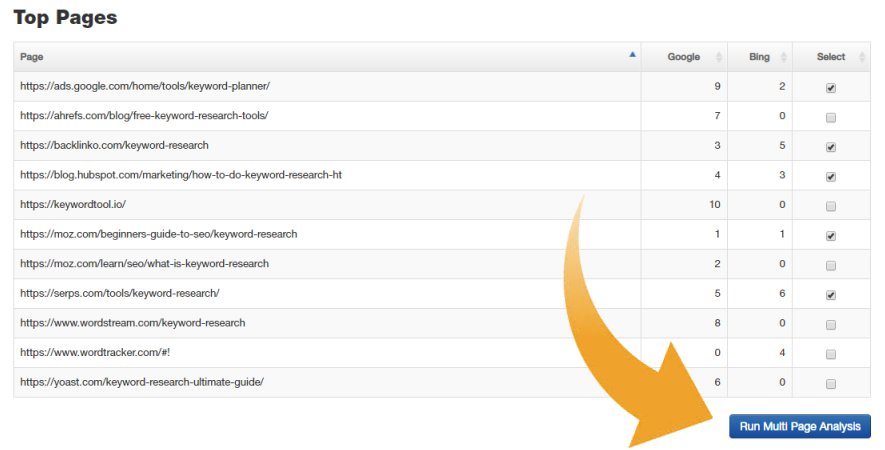
Figure 4: SEOToolSet’s Research Summary tool lets you identify, select and quickly analyze top-ranked pages as a group.
The Multi Page Analyzer summarizes the high-ranking pages for your keyword (Figure 5). More importantly, you receive a footprint of the common characteristics of the top pages. Using this data, you establish recommendations for making your own page for that keyword more like the ones Google is already rewarding.
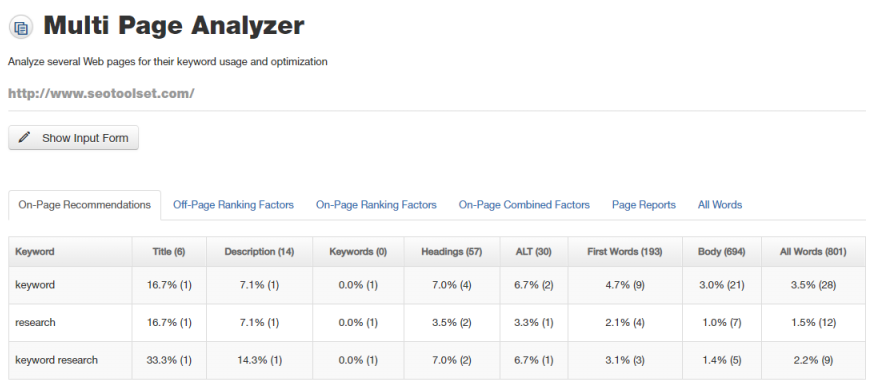
Figure 5: Multi Page Analyzer results show the keyword-usage behavior of the top-ranked pages.
Search Engine Index Tools
The last test is to evaluate each major engine by using advanced search operators, which we explain in detail in our Advanced Search Operators Guide.
One of the most important factors in search engine rankings is how much content a site has about a subject (aka depth of content). Use the site: search to search for content just within one domain. For example, the query site:domain.com peanut butter would show the pages on a domain the search engine views as most relevant for peanut butter.
Use a site: query to check your domain or the domains of your competitors to see the important pages on each site that are ranking for your terms. You’ll want to examine these pages and take note of what they offer. Do they have a lot of content? Videos? Charts? Interactive elements? For your page to be competitive, strive to make it the best page for that query. How can you do an even better job of meeting the needs of your users?
How Can You Implement Clear Subject Themes?
You now know what keywords the site is ranked for, which subjects the site is considered to be relevant for, and a good idea of how your major pages compare to the competition. You first want to make your site as good as the competition. Then you must make your site better than the competition. You want the search engines to see you as first among equals — the most relevant resource on the web. It is important at this point to identify the gaps in your silos: areas that are relevant but which are not yet supported by obvious content on the site.
Consider what your site is not about, and what terms are not important. Is it worth the effort to make content for those pages? Do you want to dilute your site’s theme with off-topic content, making your site seem less relevant for important terms? It is important that you make these choices now and consider the ramifications of each theme-based keyword phrase decision.
Establishing a Clear Theme
There are many ways to establish a clear theme. It helps to visualize the primary and secondary categories that you would prefer your site to be about, either with an organizational chart template or a simple outline list in a word processor (Figure 6).
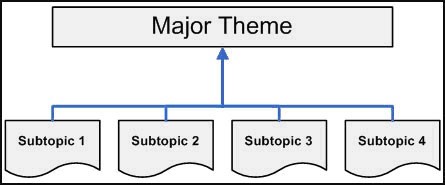
Figure 6: Subject organization chart
Once the themes and subtopics of a website are decided, it’s time to apply the themes to the site in a recognizable way. Creating theme-based silos throughout a website is a way to clearly communicate the relevant themes of a site to search engines and human users.
There are two distinct methods of siloing: physical directory silos and virtual silos.
Both allow site owners to create tight themes through linking strategies; however, they approach the concept very differently. Virtual siloing is essential; physical siloing reinforces the themes but is not always feasible. Regardless, you should design the silos before creating the website, if possible. Doing so gives you more control with your design process.
We developed our siloing technique after discovering that many of our clients expressed difficulty in ranking both for their site’s generic keywords (e.g., jelly) and for specific page terms (e.g., organic strawberry jelly). We found that by haphazardly linking to unrelated (or even semi-related) internal pages, clients were actually diluting the theme of their website. This, in turn, caused lower rankings because the search engines were unable to identify what the site was supposed to be about.
By implementing proper siloing, site owners can reinforce their pages’ rankings for theme-specific keywords as well as general site keywords. Siloed sites can become dominant in the SERPs for important keyword phrases.
Step 2: Building a Website Theme with Physical Silos
Directory silos reinforce themes by grouping like content pages under one, highly organized directory. A minimum of five content pages are needed to establish the theme, and each must be named to reinforce the subject matter. In sites without a clear directory structure, visitors and search engines may easily miss the purpose and theme of the site.
Think of a directory silo like a file cabinet. For the file cabinet to be effective, everything must remain tightly grouped in its place and filed under the appropriate structured heading. Every distinct category has its own heading. This means if you are a site specializing in peanut butter, all of your creamy peanut butter pages would be grouped together, and all of your chunky peanut butter pages would be grouped together.
The two would never be mixed as either content or cross-linking. A creamy peanut butter silo might look something like this:
A creamy peanut butter silo might look something like this:
-
- Peanutbuttersite.com/creamy/traditional/
-
- Peanutbuttersite.com/creamy/organic/
-
- Peanutbuttersite.com/creamy/lowfat/
-
- Peanutbuttersite.com/creamy/jellyhybrid/
- Peanutbuttersite.com/creamy/honeyroasted/
In the example above, each page is named to help the search engines see the common theme. The directory naming system helps establish that these pages are all about creamy peanut butter. Sticking to this format helps prevent your themes from blurring.
Most sites will find that their topic is broad enough that they need to separate it into multiple themes. If you find that your creamy peanut butter silo can be divided even more, you may create multiple subsilos, however keep the number within reason. We recommend keeping the subsilos to two or three directories deep. Going deeper than that may cause deeper pages to not receive enough inbound link value to be considered relevant.
Additional silos give you more room for keywords and keyword synonyms. The tighter your silos are, the better your chance at ranking for your theme-specific keywords, especially long-tail keywords. Just make sure you’re not forgetting your more general terms in the process. Your silos should target both sets of terms.
Once you create your separate themes, you may find instances where you want to connect them for the user’s benefit. For example, let’s say your peanut butter site has a silo about the health benefits of different types of peanut butter. If you have a page that specifically addresses the health benefits of creamy peanut butter, it may make sense for that page to refer to both the health benefits section and the creamy peanut butter section of the site. The best way to do this without diluting your theme is to link from the creamy peanut butter page to the health benefits landing page. This shows the engines that you have two unique silos and makes it easier for both pages to stand out. Linking at will can cause confusion for the engines as they try and decipher what your page and site are about.
For the remainder of this article, we’ll use historic views of Heifer International organization’s website as a case study to evaluate siloing best practices. Although the specific recommendations that follow are for Heifer.org, the general principles of silo building apply universally.
Physical Siloing on Heifer.org
Most of the visitors from organic search come to the Heifer.org site with terms related to the Heifer brand name. Though these terms produce high-activity traffic deserving of this charity’s high profile, these keywords do little to attract new visitors who are unfamiliar with Heifer International. It is important to unravel how this site fails to take advantage of non-branded terms with a high search volume to help the site attract and accommodate new visitors.
Heifer.org discusses many subjects throughout its site, documenting charitable success and the impact they have made toward ending hunger in Africa. However, all this information is not organized in an easily understandable way, nor does it explain to the visitor, be it human or spider, what benefit donating to Heifer International may provide the governmental, corporate, philanthropic, religious or fundraising groups that make up the targeted audience. In other words, the site fails to address the very people it hopes will donate, thereby excluding large groups from ever being exposed to Heifer International.
To learn from Heifer.org, let’s begin by exploring the directory organization of the website.
URL Structure
The page URLs are numeric page names and lack any sort of logical subject grouping:
Homepage: http://www.heifer.org/site/c.edJRKQNiFiG/b.183217/
Our Work: http://www.heifer.org/site/c.edJRKQNiFiG/b.201470/
Get Involved: http://www.heifer.org/site/c.edJRKQNiFiG/b.201471/
Under each major navigation section there are subcategory sections: Our Work, Get Involved, Give, Learn, and Inside Heifer. While these subjects may make sense to a human visitor, they do not do much to strengthen the site in the search engines for subject-specific terms with a high search volume. After reviewing the site and its rankings for each major section, we see it is cleanly divided into five main parts plus the homepage (Figure 7).
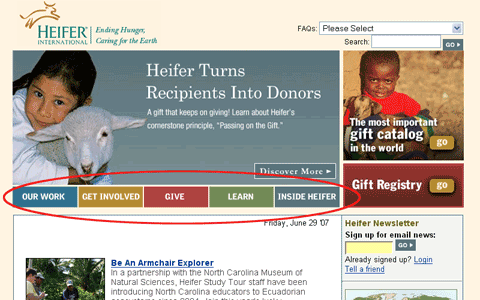
Figure 7: Heifer.org’s navigation
Subject Categories
Each major category is relevant for a primary subject theme so that the site can be organized as shown in Table 1:
| Heifer.org’s Top Subject Categories | Subject Focus |
| Home Page | Heifer branding |
| Our Work | Get involved |
| Get Involved | Get involved |
| Give | Heifer donation |
| Learn | How to end world poverty |
| Inside Heifer | Heifer Projects |
Table 1: Primary category pages for Heifer.org
The categories above appear adequate on first glance; however, upon closer observation the categories are missing opportunities for which a high-profile charity website is relevant.
Based on the subject grouping used site wide, Heifer International is missing out on thousands of monthly visitors, and potentially hundreds of thousands of dollars in donations from wealthy benefactors, governmental giving, corporate giving, fundraisers and individuals. Heifer.org’s site serves as an educational tool about its own charity, but it offers little for the people whose donations it needs to obtain its objectives.
Branded Keywords
Heifer.org’s problem is not that the site ranks poorly. In fact, we see that they are ranked for some high-activity terms. The problem is that these terms are 80 percent branded terms while the remainder is search terms that do not target potential donors.
It is critical that any charity be ranked for its name. But if those keyword phrases are all that the site ranks for, then major traffic opportunities are being missed. Table 2 shows the terms that Heifer.org ranks for; note the prevalence of branded terms.
| Activity | Keywords | Google Rank |
| 3,881 | Heifer | 1 |
| 3,880 | Heifers | 2 |
| 3,289 | heifer international | 1 |
| 1,417 | heifer project | 1 |
| 1,416 | heifer project | 2 |
| 1,416 | heifer projects | 2 |
| 425 | heifer project international | 1 |
| 346 | helping the needy | 15 |
| 222 | heifer.org | 1 |
| 158 | heifer foundation | 3 |
| 97 | the heifer project | 1 |
| 47 | what is a heifer | 6 |
| 24 | heifer international project | 2 |
| 16 | catalog heifer | 4 |
| 4 | heifer donation | 1 |
| 1 | charity donation heifer international | 1 |
| 1 | donation heifer international | 1 |
| 1 | donation heifer | 1 |
| 1 | give heifer international | 1 |
| 1 | give heifer | 1 |
| 1 | animal gift heifer international | 2 |
| 1 | heifer international donation | 2 |
| 1 | heifer catalog | 2 |
| 1 | heifer project international | 2 |
| 1 | goal heifer | 3 |
| 1 | hungry heifer | 6 |
Table 2: Brand-related search terms for Heifer.org
Heifer.org also ranks well for a number of medium-activity keywords that are not brand related (Table 3).
| Activity | Keywords | |
| 207 | gift catalogue | 2 |
| 146 | world help | 8 |
| 100 | charitable gifts | 4 |
| 87 | the gift that keeps on giving | 15 |
| 67 | international gift | 7 |
| 39 | earth ending | 14 |
| 14 | international charity organizations | 7 |
| 8 | helping world hunger | 12 |
| 3 | charitable gift giving | 2 |
| 1 | animal gift give | 2 |
Table 3: Non-branded search terms for Heifer.org
Attracting Targeted Communities
To encourage the maximum number of donors to give to Heifer International, the major sections of the site should be dedicated to attracting and converting visitors to donors. Instead of expanding the website by discussing the organizational structure of the charity, more ranking benefit would be achieved by adding several pages of keyword-rich text content discussing why giving to Heifer.org is in the best interest of the donor. In fact, Heifer International does discuss these major groups, but in much less frequency than is required to rank and be relevant for donors.
The following are top categories that Heifer needs to focus on to increase the number of potential donors visiting its website.
Generic Charity / Individual Giving
The entire website should focus on the nature and benefit of giving. In discussing the larger organization, there should always be an emphasis on individuals to give what they can and how easy and rewarding it is to give. There should be generic information about charities, what a charity is, and how it operates, with an emphasis on using common charity language to make the site relevant for all generic charity keywords.
Add 5–10 articles to the /charitygiving/ directory using the keywords listed below:
- advocacy
- altruistic
- charitable giving
- charities
- charity
- donation
- giving
- non-profit
- poverty
- volunteer
Celebrity / Philanthropy
A major section of the site should address wealthy established families, celebrities and philanthropists, welcoming and inviting them to give. Discussion of all legal and related information should be provided to fully explain the benefit of a donation.
Add 5–10 articles to the /philanthropy/ directory around these keywords:
- advocacy
- altruistic
- benefactor
- Bill and Melinda Gates foundation
- celebrity
- philanthropy
Estate Planning
Build several pages answering the question “Why should Heifer.org be made a benefactor in my will?” Explain through case studies or specific examples why Heifer International should be a “charitable trust” within a will or inheritance.
Add 5–10 articles to the /estateplanning/ directory focused on these keywords:
- charitable donation
- charitable giving
- charitable reminder annuity trust
- charitable trusts
- charity as a beneficiary
- contingent IRA beneficiaries
- estate taxes
- IRA money
- retirement accounts
- state estate tax
- wills and estate planning
Governmental Giving
Explain the nature of nonprofits and the benefit of charities within the context of federal and state law. Explain the economics of charities, why governments can give more, or what inherent problems are associated with charitable donations.
Add 5–10 articles to the /nonprofit/ directory targeting these keywords:
- advocacy
- aid
- atonement
- bureaucracy
- charities
- donations
- humanitarian aid
- nonprofit
- nonprofit organizations
- poverty
- property law
- surplus
- tax deduction
- tax exemption
- United States of America
Step 3: Building a Website Theme with Virtual Silos
A website can be viewed as both a single entity that is part of the internet, and as a group of individual pages that make up the site. What search engines attempt to do is categorize the information on individual sites into content groups. Search engines consider links between and within sites to be a strong signal of subject relevance.
Virtual silos use a drill-down cross-linking structure to create distinct subject categories. In other words, the theme of the top landing page is supported by relevant pages linking to it. Virtual siloing may be useful for an established site that does not have a directory file system set up or can’t break established page locations to change site architecture.
In a virtual silo, each supporting page is linked to the category landing page and also linked to the other supporting pages for that theme. The theme of the silo is created and reinforced by this type of cross-linking of the pages. With virtual siloing, pages don’t need to be in the same directory to be in the same silo; the theme is established solely through the use of links.
For example, let’s say you want to create a virtual silo for crunchy peanut butter using the following five crunchy peanut butter pages as support pages:
-
- Peanutbuttersite.com/crunchy/superchunk/
-
- Peanutbuttersite.com/crunchy/lowfat/
-
- Peanutbuttersite.com/crunchy/organic/
-
- Peanutbuttersite.com/crunchy/jellyhybrid/
- Peanutbuttersite.com/crunchy/almond/
To create the virtual silo, all five pages would link to the crunchy peanut butter landing page. This tells the search engines that these pages are related to and support the topic presented in the landing page. Each page should then also include a link to every other support page in the virtual silo. In this case, each support page would link to the four other support pages of the silo. The easiest way to do this is to include navigation on the page to link the pages together, essentially creating a category-sitemap on the page.
When linking out to other pages in the site, you must be very cautious about risking the integrity of your silo. To link two related peanut butter pages found in separate directories, link only to category landing pages. Linking this way will help build the theme of each silo. As mentioned earlier, when linking this tightly, beware of failing to address your general keywords.
Sticking with the simple peanut butter example, say your site sells a flavor of jelly that is particularly complementary to creamy peanut butter. It may be fitting to link from your peanut butter page to the flavored jelly page. Since the jelly page would be a supporting page in the jelly silo, you would want to link your creamy peanut butter page to the landing page of the jelly silo instead of to the particular flavored jelly page.
Linking from support page to support page in different silos dilutes the themes of both silos. By linking to the top of the jelly silo, you not only keep the integrity of the two silos, but also you help to establish the jelly landing page as the main page for that silo. If you absolutely had to link the creamy peanut butter page to the flavored jelly page, you would want to do it with a rel=”nofollow” link attribute. The rel=”nofollow” link attribute is a signal to the search engine not to pass PageRank, the indicator of link value or relevance.
Cross-silo and inner-silo linking, collectively called internal site linking, is one important part of virtual siloing best practices. The three main linking types that affect high keywords rankings are: inbound linking, outbound linking and internal site linking.
Virtual Siloing on Heifer.org
As before, we are using a historic version of Heifer International as our case study. Heifer.org stands to improve its subject relevance through virtual siloing practices, including improved anchor text, inbound linking, outbound linking and internal linking.
Anchor Text
The anchor text directly affects the subject relevancy for all types of linking. As discussed earlier, Heifer International chooses anchor text throughout their website that fails to address their target audience, thereby making their site relevant for the wrong audience.
Choosing the most appropriate keyword phrase to use as the anchor text will not only help to improve keyword rankings, but it will increase targeted fundraising to the site by helping to match donors with a worthy cause that meets their interest in giving and social justice. What improving link structure actually does is bring the most relevant audience/visitors to your site. Visitors are much more likely to click on the search result if it addresses the most relevant keyword phrase.
Inbound Linking
The majority of the websites that link to Heifer.org (Figure 8) use only the company name, “Heifer International,” in the link text, which helps the website to rank for the company name. To rank for subject-related terms, the site can benefit from having some inbound link anchor text that includes subject relevant keyword phrases. However, this should not be forced or too repetitive; wording needs to be natural and show some variance, otherwise Google will suspect the site of buying or manipulating links.
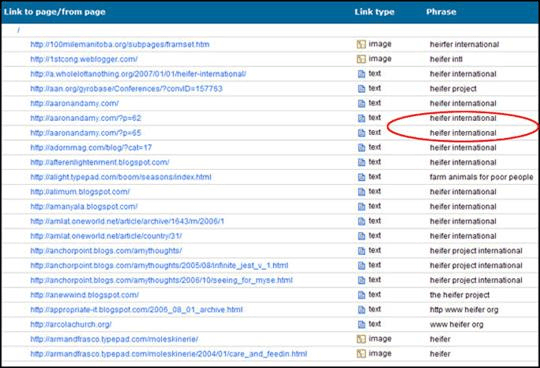
Figure 8: Inbound links to Heifer.org showing the anchor text of each link
Google has a system that assigns value to inbound links called PageRank (PR). Google considers a hyperlink to a page to be a “vote” of support for that page. Every site on the web has a certain amount of PR, based on these votes and how much PR the linking pages have. PageRank is distributed within all websites based on which site pages are linked to from third-party sites and by the site’s internal linking.
What are the possible factors that Google uses to determine the value of an inbound link?
Keyword-Rich Anchor Text
The link anchor text should contain appropriate relevant keyword phrases (e.g., charity giving, religious charity). The link text must also match the page subject to be considered subject relevant.
Relevant Websites Link to Relevant Categories
A relevant website linked to the most relevant category on the website offers the highest value. A link from a page that has little or no relevance may harm or dilute the link value or overall website.
Natural Link Acquisition
It is important to have other high ranked websites pointing links to your site; however, if the only websites that link to your site are of expert quality, it may seem artificial or suspicious to search engines. It is a more natural pattern to see a variety of new and more established sites linking to your site acquired gradually over time rather than instantaneously.
Do Not Buy Links
The most important guideline of link building is don’t buy links. Buying links is one of the tactics that Google is trying to eradicate from the internet. Link buying for the purpose of passing PageRank may lead to severe penalties with the search engines.
Outbound Linking
Links out to other websites are called outbound links and are the least understood link structure elements.
Often, the drive to build inbound link campaigns dominates link structure projects while outbound linking remains ignored and misunderstood. Companies specifically express concern that they will likely lose traffic and customer sales if they link to relevant information, products or services on other sites. However valid these concerns might be, most sites are unaware of the harm that failing to link out causes to their search engine rankings.
It is natural for an expert to link to other experts (see Figure 9). The effort devoted to building inbound links is only effective when balanced with some appropriate outbound linking, which is evaluated through the same type of keyword focus factors. You must serve as a hub to other authority sites or else you are not much of an expert.
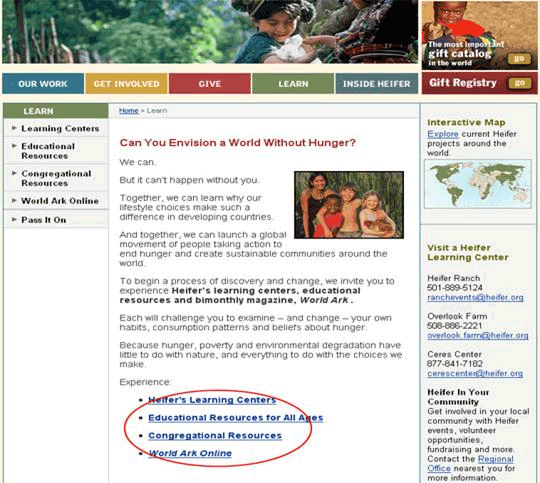
Figure 9: Outbound link anchor text on heifer.org
Outbound Anchor Text
The anchor text that points to another site must be evaluated with the same scrutiny given to inbound links. Evaluating the competition is critical to understanding why a site has high keyword rankings.
The keyword phrases used as anchor text should reflect the same type of keywords that the site is trying to rank for itself or identify the brand or domain. For your users, you want to clearly represent what they’ll see when they click a link. For search engines, it reinforces your expertise. To be a subject matter expert on a subject, link from that silo to other experts on that same subject as appropriate.
Linking to Relevant Compatible Websites
To establish subject relevance, it isn’t necessary to link to your direct competitors; rather, choose compatible and related websites. Often, subject experts are education or news sites, or compatible services that complement a site’s products or services.
Do Not Sell Links
Finally, mind the warning and do not sell links to other sites without the inclusion of the rel=”nofollow” link attribute on those links. For example, ads on your site will be nofollowed.
The practice of selling links that transfer PageRank, no matter how tempting, can be met with very strong search engine penalties and possible bans that can remove the website from the search engine. Remember that Google’s quality formula E-E-A-T includes trustworthiness as a pillar.
Internal Site Linking
Subject relevance can be built on-site using the navigation and on-page elements. Arrange the main subjects in most rational manner (based on how people search) to build subject relevance. Organize menus to categorize the site’s content and categories.
The browser renders code including the site menu in a visually engaging way, as seen in Figure 10. However, search engines often see a page stripped of images and graphic elements, as seen in Figure 11.
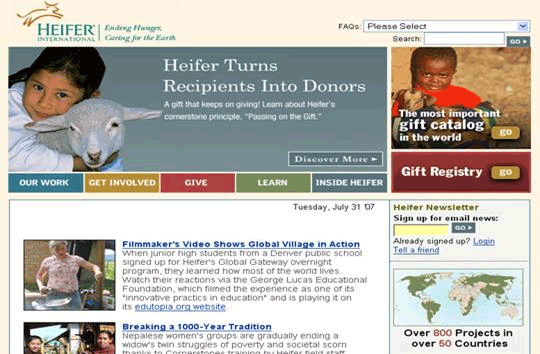
Figure 10: Heifer.org’s homepage rendered by a browser
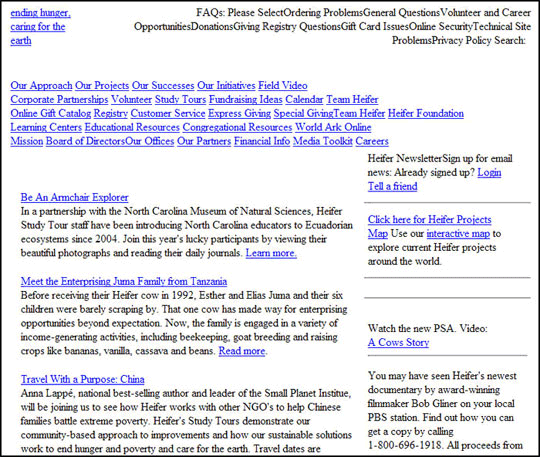
Figure 11: Heifer.org’s homepage cache
The difference between how a search engine views this menu and how a human views this menu in a browser has both positive and negative aspects. That all the links can be followed and that the site is readily index-able is good. That the menu’s link structure does little to clarify the website’s main subjects is a missed opportunity.
Hierarchical Top Level and Sublevel Navigation
As mentioned above, the menus are thoroughly index-able; however, the menus do not help to classify the main subjects, which are: Charitable Giving, Philanthropy, Wills and Estate Planning, Non-Profit Organizations, World Charities, Church Fundraiser, Corporate Responsibility and Fundraising Ideas. The above categories should replace the top-level navigation elements as anchor text shown in Figure 12.

Figure 12: Heifer.org’s sub navigation
It’s recommended that the sub navigation elements be subjects that support the main category. In this example, let’s replace “Give” with “Philanthropy” and alter the sub navigation as follows:
- Celebrity
- Advocacy
- Philanthropy
- Bill and Melinda Gates Foundation
- Benefactor
- Altruistic
Menu items should support the main category and provide links that are relevant to the category subject. For example, the subjects of Corporate Responsibility and Individual Giving are not compatible except in the loosest sense.
The second level navigation represents the individual landing pages of the primary silos and the purpose of this navigation is to focus on the subcategories or secondary silos of this section of the Website. The very elements that exist in the drop-down elements are rendered on the page within the most appropriate way possible. Take the green Learn menu item on the Heifer.org site.
The left navigation (Figure 13) is a perfect example on how to outline secondary silo elements on the primary silo landing pages. It tells both user and search engine alike exactly what the user can expect to see when further exploring that information category.
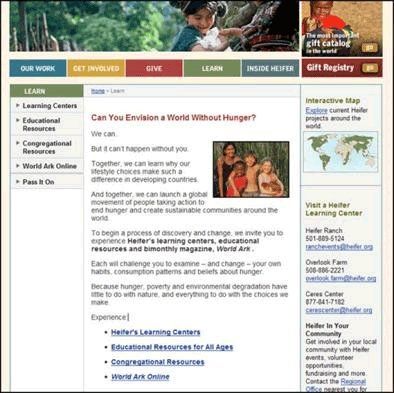
Figure 13: Heifer.org’s secondary navigation
Cross-Linking
When inner linking throughout the site, link like-subjects together and divide unrelated categories. Use the link structure to channel relevance and be careful not to interlink subjects that break down or dilute subject themes.
Rel=”NoFollow”
When you link between different silos within the site, you may always link normally to a landing page. When linking between silos and the target page is not a landing page we want to have ranked, in that case we would use a nofollow link attribute. Add the rel=”nofollow” attribute to eliminate passing PR when linking two subjects outside of silos. This will allow unrelated pages to link to each other without confusing the subject relevance. A rel=”nofollow” removes the PR relationship between two or more pages.
Possible Alternatives to Eliminate Excessive Navigation or Cross-Linking
When it is impossible to remove menus that contradict subject relevant categories, instead use technology to block the search engine spider’s indexing of those specific elements to maintain quality subject relevance.
Striking a balance between these elements of link structure, including inbound linking, outbound linking and internal site linking will serve to create maximum subject relevancy. Learning to control subject relevance requires a firm understanding of your subject and who you choose to include in your link network.
Step 4: Creating Keyword-Rich Content
Content is king. At least that’s what we have been telling others all these years. The truth is that the importance of content has to be qualified.
Content is king, but not all content is created equal. Your content needs to be written with specific qualities in mind to fulfill the standard that search engines are looking for today. It has to meet a number of guidelines before it is even considered worthwhile, and even then it might not be enough to satisfy your ROI in helping to improve your rankings.
Content Requirements
The first step in creating keyword-rich content is to look at how much content needs to be written or otherwise provided to be competitive in the top results.
Knowing exactly how much content you will need to have a top ranking in the search engines can be incredibly empowering. While the content alone is not enough to rank well in the search engines, having “enough” is essential to rise to the top of the search results.
What’s more, the amount of content being rewarded for each keyword phrase is able to be computed. Even a competitor that has thousands more pages is vulnerable when the mystery of their ranking is unlocked.
We have spent a great deal of time looking at Google, as optimizing for this search engine delivers the greatest potential reward for efforts. How does one determine how much content a website needs to effectively compete in Google? The answer is to use special Google operators to find the data that we will need to identify competition and content volume, then analyze those pages as a community in our Multi Page Analyzer.
Google Operators
One way to determine how Google evaluates website content is by using Google operators (see the list here: https://support.google.com/websearch/answer/2466433). For example, you can use a search operator to identify how many pages a site may have within the Google index, in total or on a certain topic.
Site Command + Keyword Phrase
The first operator is the “site:” command. Combined with a keyword phrase, the “site:” command allows you to identify approximately how many pages a specific site has about that specific keyword phrase (Figure 14).
Example: site:fundraising-ideas.org fundraising ideas

Figure 14: Site: command in Google search box
https://www.google.com/search?q=site%3Afundraising-ideas.org+fundraising+ideas
Allintitle Command
The second operator is “allintitle:” which helps to identify how many pages in the Google index use the keyword phrase within their title tag (Figure 15).
Example: allintitle: fundraising ideas

Figure 15: Allintitle: command in Google search box
https://www.google.com/search?q=allintitle%3A++fundraising+ideas
The combination of these two search engine evaluation techniques will give you a good idea of how much content is likely needed to compete with the top ranking pages. It also may remove a bit of the mystical quality of search engine ranking and put critical information into the site owner’s hands.
Content Measurement and Evaluation
Let’s revisit the nonprofit site Heifer.org and examine a sample of their primary and secondary silo categories. We’ll use the two operators above to determine how much content will be required to compete for a given keyword phrase.
Typically a charity website would have some existing content focused on many of the main fundraising and charity-centric subjects that they target. However, in the case of Heifer.org, the site does little to describe the people from whom they are trying to solicit donations. Below is a potential breakdown by type of target audience and some possible related keywords.
Charity Giving / Individual Giving keywords
Giving, Charity, Poverty, Volunteer, Charities, Donation, Non Profit, Advocacy, Nonprofit, Charitable, Giving, Altruistic
Celebrity / Philanthropy keywords
Celebrity, Advocacy, Philanthropy, Bill and Melinda Gates Foundation, Benefactor, Altruistic
Estate Planning keywords
Charitable Trusts, Charitable Remainder Annuity Trust, Charity as a Beneficiary, Charitable Donation, Wills and Estate Planning, Estate Taxes, Charitable Giving, IRA money, Contingent IRA Beneficiaries, Retirement Accounts, State Estate Tax
Governmental Giving keywords
Surplus, Poverty, Aid, Charities, Advocacy, United States of America, Nonprofit, Non-Profit Organizations, Donations, Tax Deduction, Property Law, Tax Exemption, Atonement, Humanitarian Aid, Bureaucracy
World Charities, Africa Charities, Asia Charities keywords
AIDS, Africa, Agriculture, Malaria, Apartheid, Genocide
Religious Giving / Charity keywords
Christianity, Judaism, Catholic Charities, Lutheran, Roman Catholic
Corporate Giving keywords
Corporate Identity, Commercial Law, Corporate Social Responsibility, Capital Gains Tax, Tax Deduction, Atonement
Fundraising keywords
Fundraising Ideas, Fund Raising Ideas, Fundraiser Ideas, Fundraising Companies, School Fundraiser, Churches, Church Fundraiser, Sports Teams, Day Cares, Charities
Competitive Research of Content Measurement
Beyond just measuring the quantity of pages, we must also investigate the quality of the content on the average page throughout a given site. We are going to evaluate how many words should be used per page and the complexity of how the content is laid out on the page, using the fundraising silo as an example.
| Secondary Silos | Site + Keyword (body content) | (keyword in title) |
| Fundraising Ideas | fundraising-ideas.org (439) fundraisinghelp.com (3,040) easy-rundraising-ideas.com (585) |
33,100 |
| Fundraising Companies | fundraisingweb.org (194) fundraisingdirectory.com (23) fundsnetservices.com (49) |
1,7700 |
| School Fundraisers | school-fundraisers.com (28) childparenting.about.com (42) |
6,430 |
| easy-fundraising-ideas.com (255) | ||
| Church Fundraisers | easy-fundraising-ideas.com (284) withinhisgrace.com (171) fasttrackfundraising.com (186) |
310 |
| Sports Team Fundraisers | sportsfundraisers.com (5) fundraisingzone.com (74) mysportsdreams.com (18) |
19 |
| Church Fundraisers | easy-fundraising-ideas.com (284) withinhisgrace.com (171) fastrackfundraising.com (186) |
310 |
| Sports Team Fundraisers | sportsfundraisers.com (5) fundraisingzone.com (74) mysportsdreams.com (18) |
19 |
Table 4: Data showing the relative competitiveness of keywords in the fundraising silo
Review the tables to learn how much content is required to compete for a given keyword phrase. Use these samples to estimate the amount of content required on the site to compete with top-ranking results.
Remember that there is more to ranking a website than just writing content. The higher ranked the website, the more likely they are to have the highest number of pages about a subject. Other factors, such as the authority of the site overall, also influence individual page rankings.
These content estimates must fall under the same level of scrutiny you give any other siloing category and need to be considered as one factor in the overall silo construction.
Competitor Analysis: fundraising-ideas.org
Let’s look at a competitor, the site fundraising-ideas.org (shown in Figure 16).
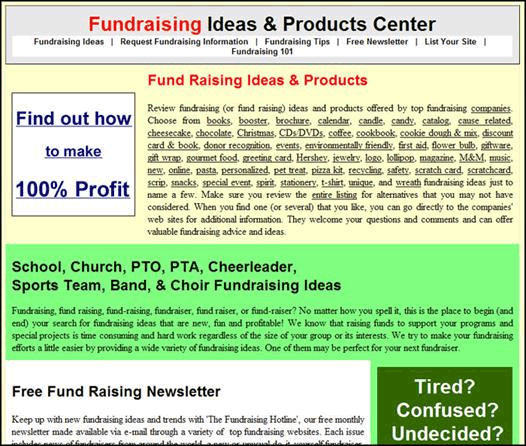
Figure 16: Homepage of fundraising-ideas.org (historic view)
This site has a large amount of text on its homepage (Table 5), which highlights two major factors. First, “fundraising ideas” is potentially a very competitive term; second, that much of this information is probably built by volunteers. The information is lengthy and very generic with little adherence to an actual institution, which suggests it was written by well-meaning teachers and other types of educators for school programs.
| Content Measurement | ||
| Keyword Phrase | Content on First Page | # of Pages with Keyword Phrases |
| Fundraising Ideas | 699 | 439 |
Table 5: Content on fundraising-ideas.org
Competitor Analysis: fundraiserhelp.com
A second competitor to Heifer.org in terms of SEO is fundraiserhelp.com (Figure 17).
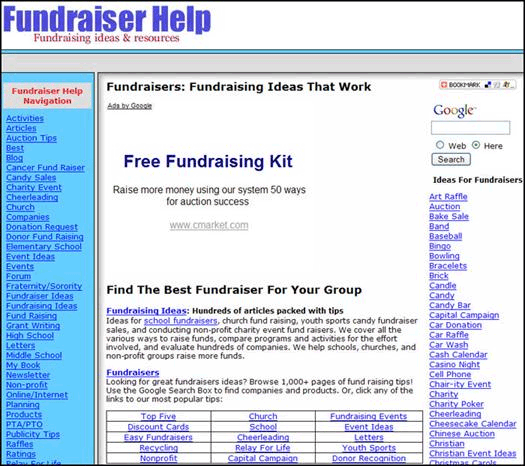
Figure 17: Homepage of fundraiserhelp.com (historic view)
Acting as more of a directory than an actual guide, the homepage of fundraiserhelp.com has generous content (Table 6). The supporting pages tend to have far less, in the realm of 50–100 words. However, there is no doubt that the homepage of a site optimized for “fundraising ideas” has to have a great deal of content on the homepage.
| Content Measurement | ||
| Keyword Phrase | Content on First Page | # of Pages with Keyword Phrases |
| Fundraising Ideas | 1068 | 3,040 |
Table 6: Content on fundraiserhelp.com
Competitor Analysis: easy-fundraising-ideas.com
A third SEO competitor is easy-fundraising-ideas.com (Figure 18).
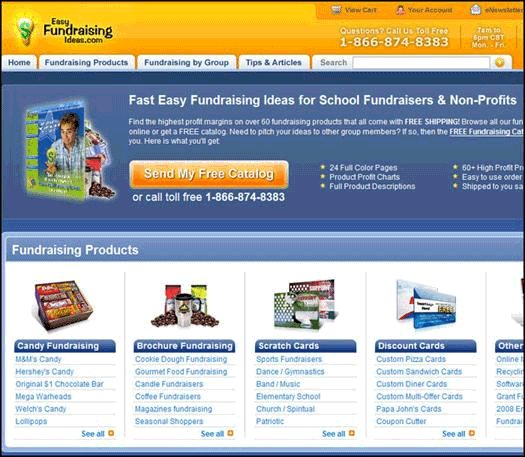
Figure 18: Homepage of easy-fundraising-ideas.com (historic view)
The majority of content on easy-fundraising-ideas.com appears toward the bottom of the homepage. Each site has numerous on-page links, but this site far exceeds the recommended norm of less than 15 percent.
| Content Measurement | ||
| Keyword Phrase | Content on First Page | # of Pages with Keyword Phrases |
| Fundraising Ideas | 585 | 921 |
Table 7
Using the Competitor Analysis
From the results of our competitive analysis, we can determine a range of content that we should be aiming to meet. Use the lowest content measurement among the top 10 as a milestone. If you start by budgeting for the lowest denominator, you can make it your goal to aim higher over time. It is much more important to get in the game than become overwhelmed by the seemingly impossible task of immediately being the best.
Providing the best content to match a searcher’s intent is key. Certainly, it is about more than quantity of content or usage of keywords. So you might ask yourself if it is practical to pay very much attention to these figures. However, this data is valid especially in very competitive fields, all other things being equal. Many competitors are likely to implement such strategic recommendations. And study after study has supported the ranking value of longer versus shorter content.
Set realistic goals to begin with. Start somewhere and chart the site’s progress with each major content addition.
Keyword Densities
Keyword density itself is not a meaningful number when looking at many keywords; however, it is a useful statistic when characterizing any single keyword or keyword phrase. Beyond understanding the content volume of your own site and your competitor’s site, it also helps to evaluate and understand how keywords and their related words are used throughout the content pages of the site for each keyword.
Although there is no such thing as a “perfect” keyword density, this number can be used as a model when writing and planning content. You must understand the focus of the subject “fundraising ideas” as it is often used throughout most of the high-ranking sites. Remember to pay more attention to the density percentage and less attention to the frequency or repetition of keywords used throughout the content page.
In the SEOToolSet, you can use the Research Summary tool to identify the top 10 ranking sites in the search engines, and then analyze them using the Multi Page Analyzer (see examples in Figure 4 and Figure 5).
After you’ve submitted the keyword, the report demonstrates target recommendations for keyword usage in various page elements (title tag, meta description, body text, etc.).
Densities alone are not enough to build subject relevancy, and this report should be used only as a guideline. But it can help you craft content that’s in the ballpark of what search engines consider the natural behavior for top pages on this keyword.
Content Building Strategies
Having done the steps above, we know how much content we need to write and what is required to be competitive. Often writing this much content involves hiring a publishing staff and spending a considerable amount of money. This may be a wise move for many companies in the long run, but it’s not always possible for smaller companies. A small company isn’t going to be able to compete against organizations with a seemingly mammoth website and budget unless they get creative. A small shop doesn’t have the budget to hire a full time writer to create the content like a large company would. There is another answer, however, and here are some ideas for the exploration of content writing for the new generation.
Traditional Articles, Newsletters, Blogs
Articles and blog content is a traditional method of building relevant content on a site.
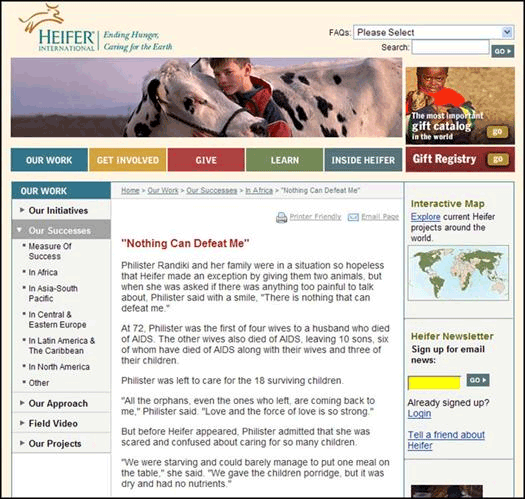
Figure 19: Article page on heifer.org
While blog posts are often created by members of the staff, authors don’t necessarily have to be dedicated writers. Any staff member of an organization may be an article author or blogger in disguise, able to write on their area of expertise.
Alternatively, blogs and articles can be authored by customers, brand loyalists or anyone who reaches out to the site with a willingness to share their story or write content.
User-Generated Content Building
One philosophy for building content solves the problem of small- to medium-size companies’ websites. There are ways to build relevance by encouraging users to become active way with the brand. Customers can contribute through a review, testimonial or comment, or may go beyond that with their own ideas for generating content through creative projects.
Reviews are powerful for building product and site credibility (see example in Figure 20).
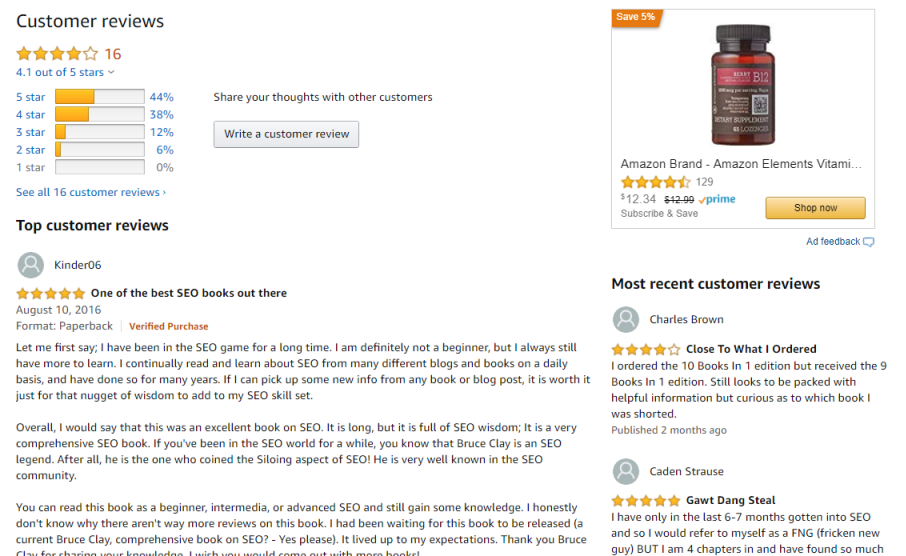
Figure 20: Amazon.com customer review page
Reviews are a great way to get users to build content-rich extensions of your site, but they can only go so far. Let’s face it — how can we get users to create content practically for free and also increase the link popularity of expertness of your site?
User Personalized Content Building
It makes sense for some sites to allow users to move right into the website with profile pages and digital identities. Then, the site can encourage them to write about their authentic experiences. Search engines and site visitors will consider this expert content about your products and services.
Create a growing and active community that will keep people on your site, creating unique, keyword-rich content. Give the power to your community to create compelling testimonials of their devotion and advocacy for the organization. Allow users the freedom to flesh out their own communities within the website and build content beyond a passive testimonial.
One example of an active community creating content is Yahoo Answers. Yahoo Answers combines all the elements that define a web community, fulfilling content creation needs and supporting subject authority.
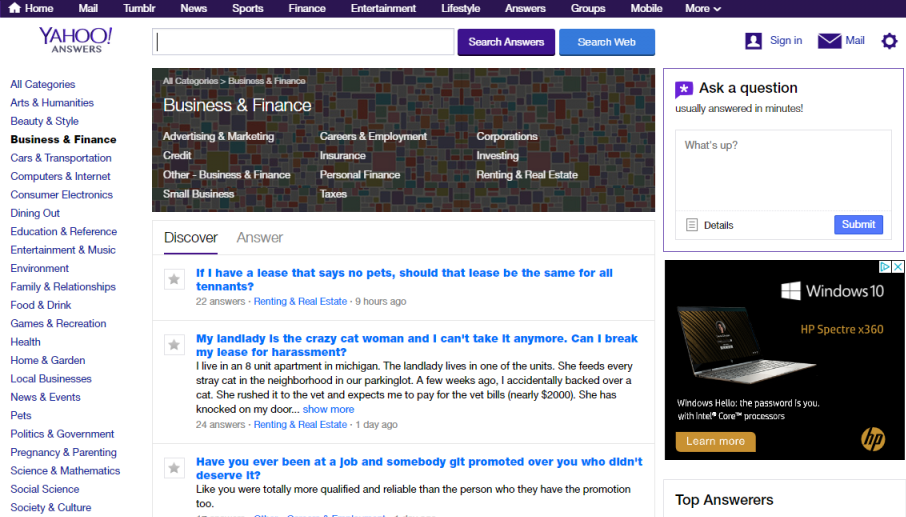
Figure 21: Yahoo Answers page
Having the knowledge to decode how search engines evaluate and categorize content brings a seemingly mysterious method into the light. Setting the bar too high by trying to compete with only the top results may lead to frustration. Instead, measure the group of top competitors and pick the most achievable goal. When writing content, get a solid idea of what the keyword density should be so that you help to increase keyword and subject relevancy. Finally, write quality content that users want or get your users to generate their own content in their own personalized space.
Sitemaps
Having a sitemap in the root directory of your website has long been of central importance to helping search engines identify all the major sections of your site. An XML sitemap is a text file you create listing all the URLs that should be indexed by search engines. It is used by the search engines for indexing purposes.
You can run a free tool that will spider your site and spit out what it thinks is the logical structure of your site in the form of an XML sitemap that can be submitted to engines.
In addition, an HTML sitemap is a page on your website that both human visitors and search engine spiders can access. Usually a site wide “Sitemap” link is part of footer navigation.
You want to set up your HTML sitemap to illustrate how content on your site is organized.
Very large sites may have multiple XML sitemaps and HTML sitemaps for different areas or the site and/or different types of content. Format them to best serve your site’s subject relevance.
For more information, read our article How to Create a Sitemap.
Silo Maintenance
Crafting category silos, both physical and virtual, managing inbound, outbound and internal links and creating supporting content for a site requires careful planning and implementation. With so many resources dedicated to establishing silos in a site, it’s just as important to maintain these silos as competitive research and additional content continue to shape the site.
It is critical to make a clear outline of your site and take steps to maintain that ideal silo structure. To carefully maintain silos, prune back and then expand silo content to improve your site’s subject relevance.
Primary Silos
We previously identified the target audience communities of Heifer.org that will bring a maximum boost in targeted traffic to the site. As explained previously, instead of focusing on the workings of the organization, Heifer.org should focus on the resources they are trying to attract. We identified the following primary terms: Charity Giving Philanthropy, Estate Planning, Governmental Giving, World Charities, Religious Giving / Charity, Corporate Giving, and Fundraising.
After doing research and selecting the primary subject, periodically decide if these are the correct keywords or keyword phrases to target in a silo. You may need to shorten or more clearly label the best phrase for the subject. Remember these phrases must be used throughout your entire site, including navigation elements, directory structure, meta information (title, meta description, meta keywords tags), on-page headings, alt attributes, and body text. All content elements must work together in as consistent a manner as possible to show the page’s relevance.
Secondary Silos
The subcategory level subjects further clarify or support the intended meaning or definition of the primary silos. These subjects will reside within menu drop downs as well as the directory structures when possible and within their own directories and page names. Each secondary element will support its own grouping of information that further defines or classifies the primary subject.
It is important to decide if these secondary keyword phrases best define the supporting subjects. Often it is necessary to rename the secondary silo label or better focus the subjects to better match the content within your site or, in the case of a new site, to write content that is even more targeted to your audience.
Silo Expansion
Commonly site owners ask “how should we modify our site to better focus our silos without losing rankings?” There are many different ways to approach this problem, but the preferred method is to think of your site as a constant work in progress. In order not to alienate visitors and keep your traffic consistent, consider expanding or growing your site one or two silos at a time and then analyze how each change affects rankings. Don’t change the site in one update and hope everything is re-indexed properly. There are hundreds of configurations of this premise that may end up being a better fit in the short term.
Subject Theming
Just as a site can benefit from slow growth, a critical part of maintaining any site is cutting back or pruning parts of the site that have diluted subject relevance. If launching a special user-centric promotion, protect silo subjects by implementing code to stop the spider from finding this link or indexing the new pages. Make it a routine part of site maintenance by remove links that draw away subject relevance.
Silos are the recommended method of architecting your site content in a way that communicates subject relevance to search engines. Begin the process of siloing by determining the targeted themes, considering the intended audiences and competition. Implement silos through the site’s physical directory structure or through the linking structure, or both, if possible. Create content for the site and encourage users to create content that supports the category silos of the site. And then maintain the site with constant research and analysis. Through this process, your site will gain authority and subject relevance as determined by search engines.
Silos have become the most significant architectural advance in the interactive marketing industry so far… it allows the construction of a website that aligns with the way users search, allows you to clearly be seen as a subject matter expert by the search engines, and delivers rankings for major keywords that convert.
For help overcoming a specific short-term SEO issue, or for full SEO services, consider contacting Bruce Clay for a free quote.
For a print version of this article, download SEO Siloing: Building a Themed Website [PDF].






